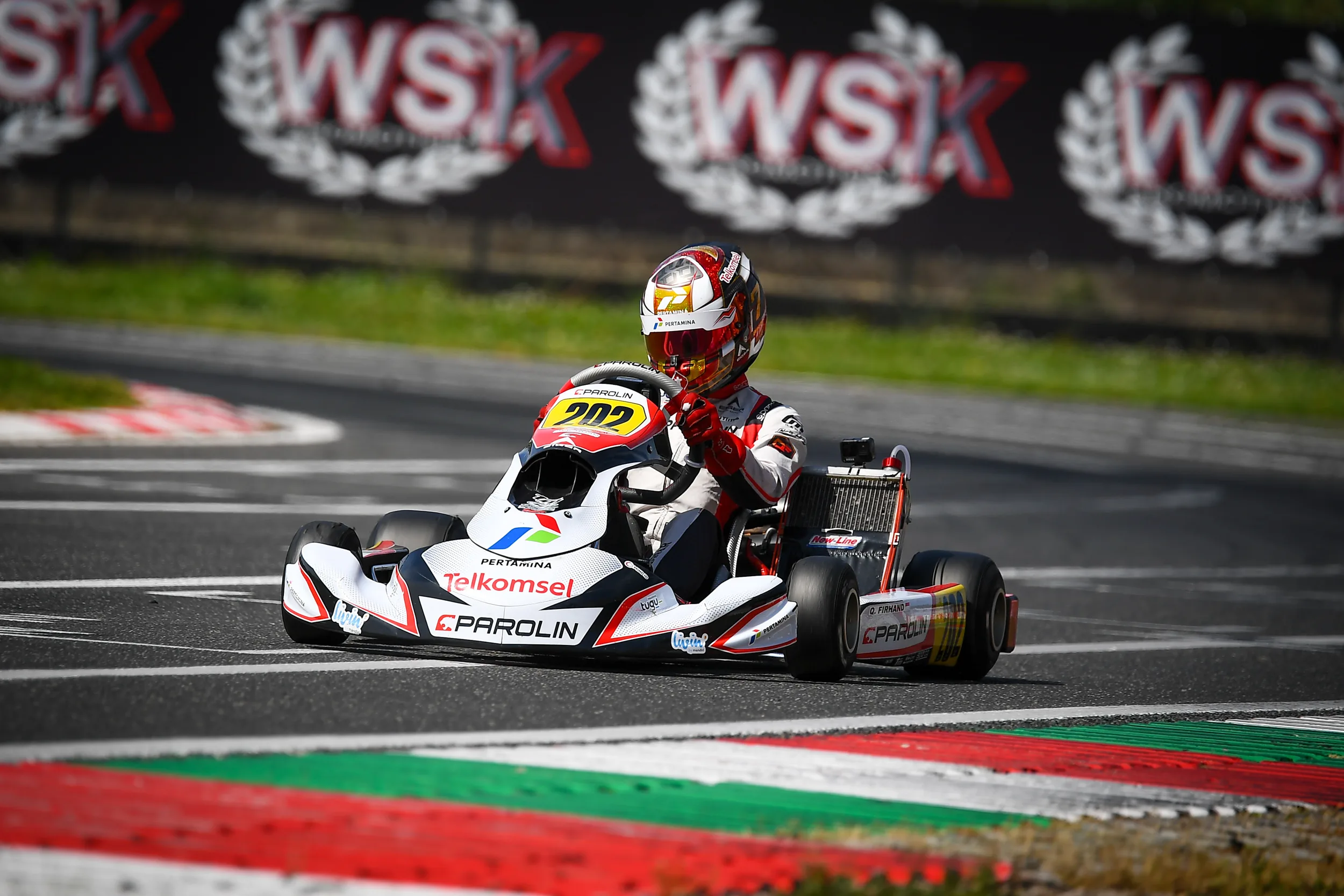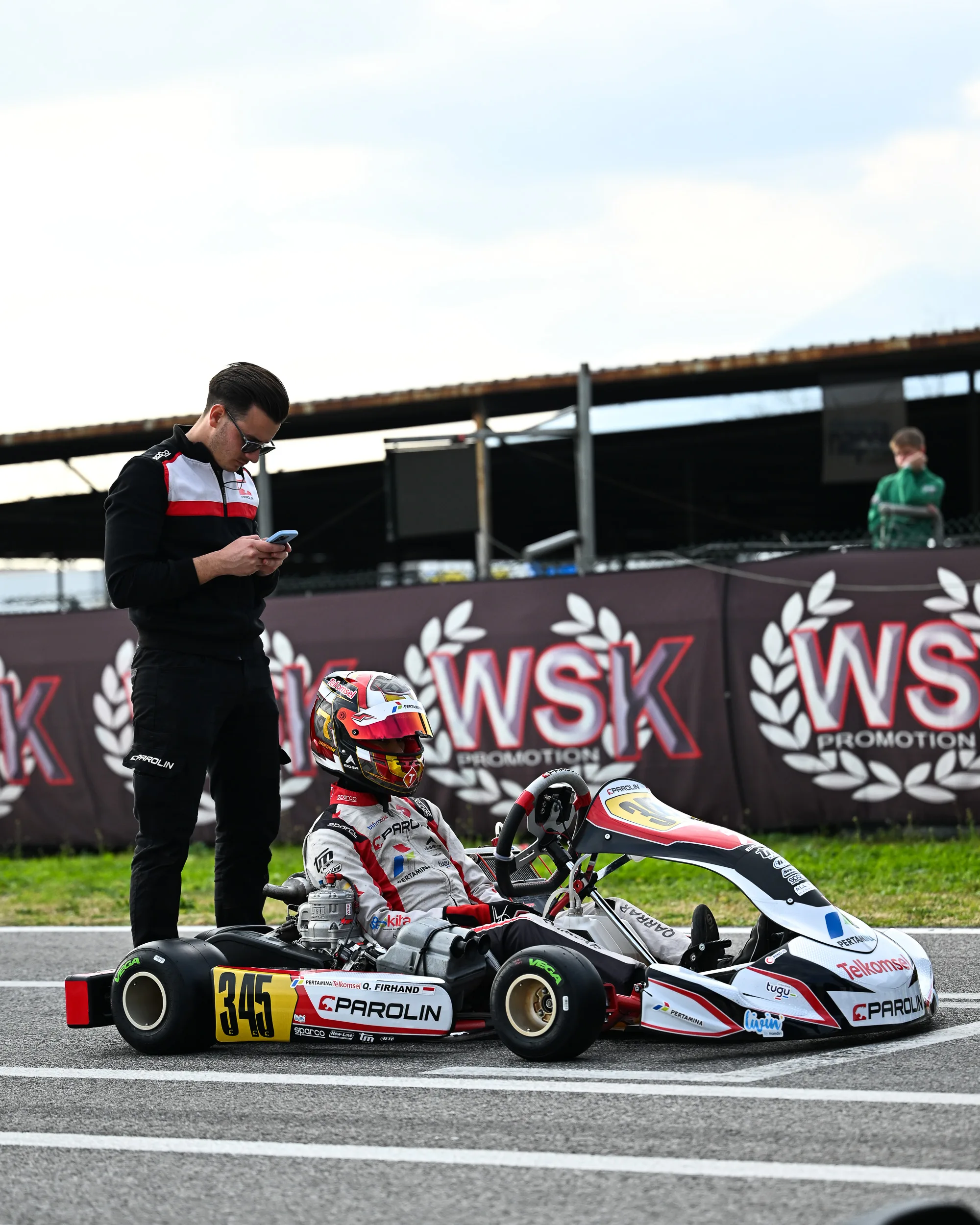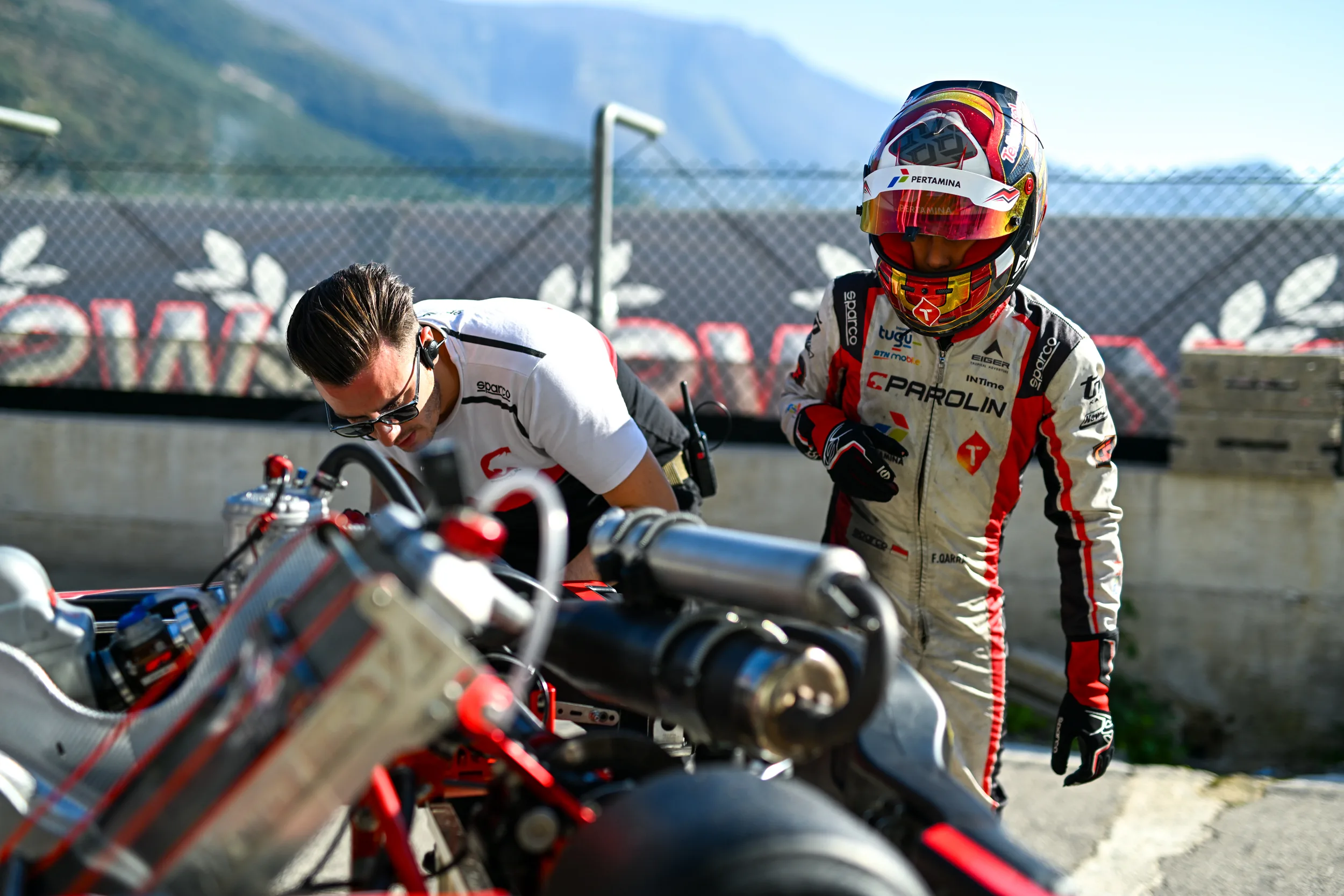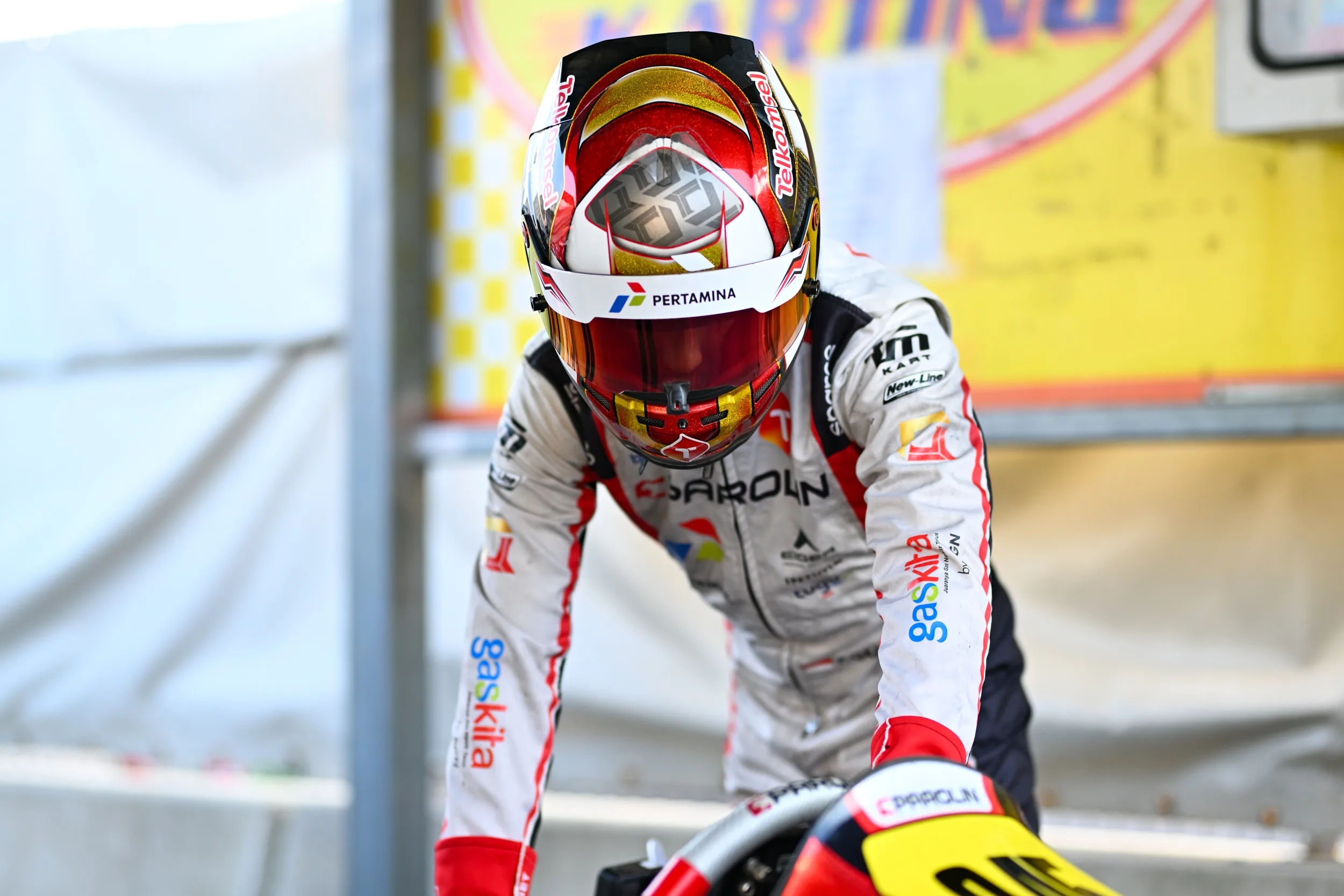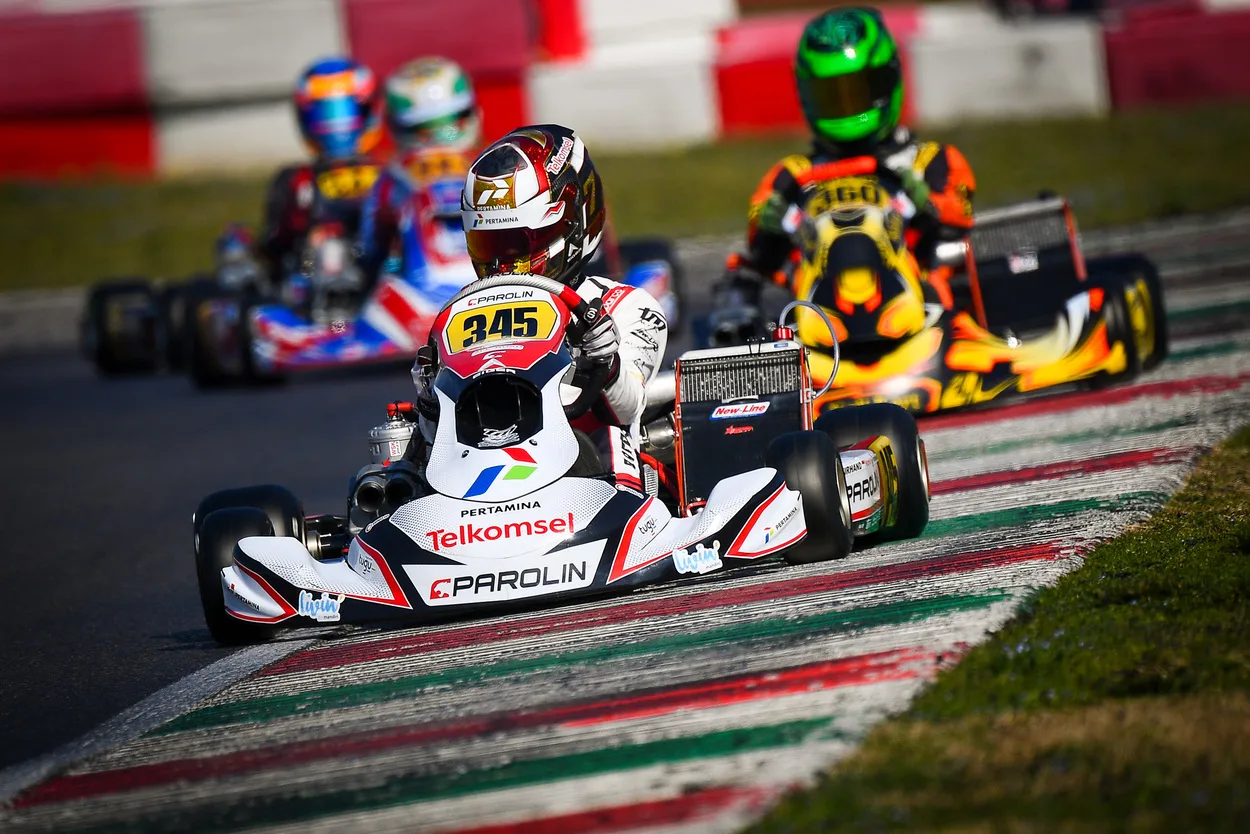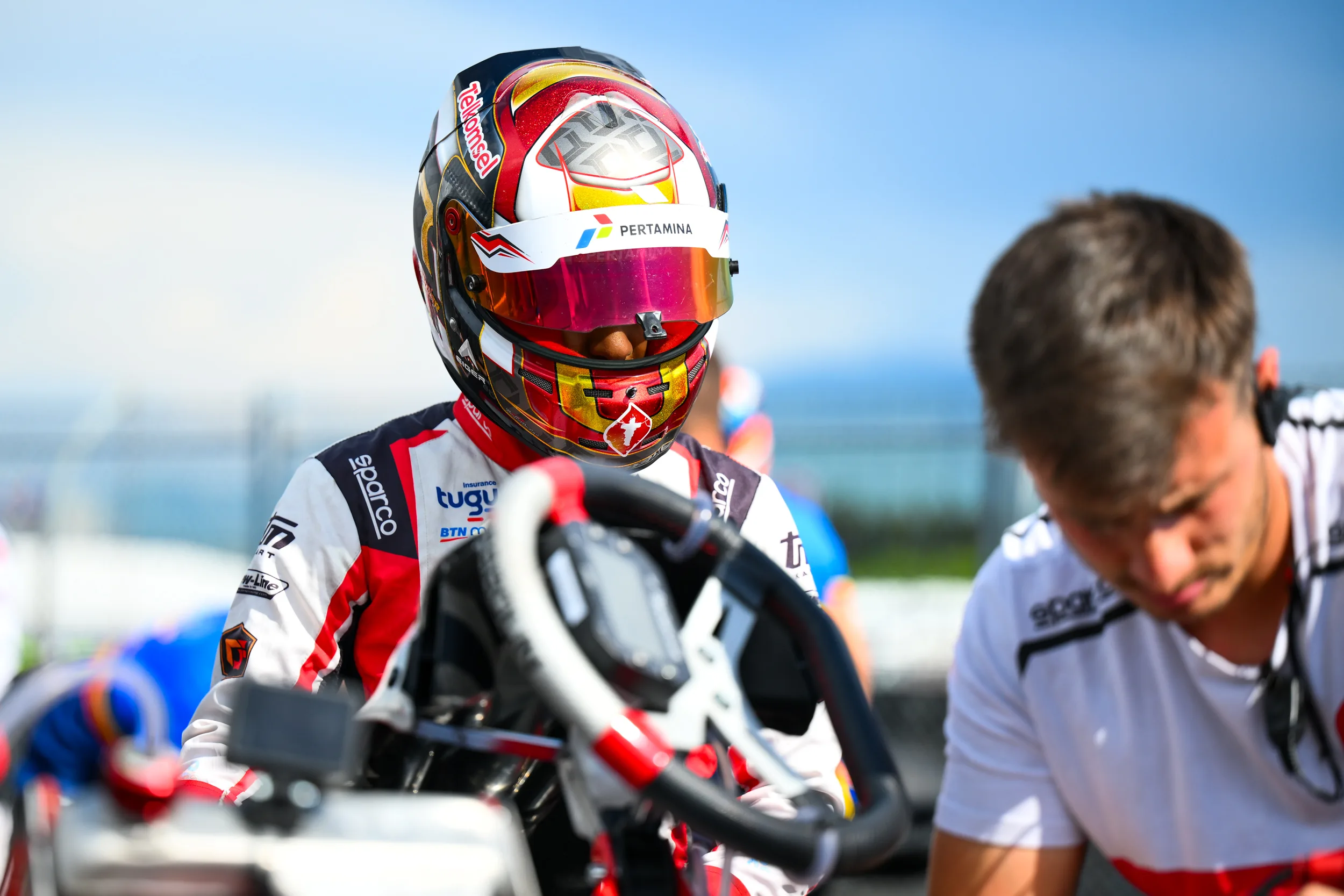For young drivers and their families, navigating the world of competitive karting can be a daunting task. Choosing the right class is crucial for a young racer’s development and success.
Two popular classes, Mini Rok and OK Junior, serve as stepping stones in a driver’s karting journey. While both classes are designed for young drivers, they cater to different age groups and skill levels.
Mini Rok is geared towards younger drivers aged 9-13, using a 60cc engine, whereas OK Junior is for slightly older racers aged 12-15, with a more powerful 125cc engine. Understanding the differences between these classes is essential for making informed decisions about a young driver’s racing career.
Understanding Youth Karting Classes
Youth karting classes provide a foundation for young drivers to develop their racing skills in a competitive yet supportive environment. These classes are crucial in shaping the next generation of racing drivers by offering a structured pathway to success.
The Importance of Age-Appropriate Racing Categories
Age-appropriate racing categories ensure that young drivers compete against peers of similar age and skill level, promoting fair competition and safety. This categorization allows drivers to progress at their own pace, mastering skills before moving to more challenging classes.
Development Pathway in Competitive Karting
The development pathway in competitive karting is carefully structured to build skills incrementally. Young racers typically begin in entry-level classes like Cadet/Bambino (ages 6-8), progress to Mini classes such as Mini Rok (ages 9-13), then to Junior classes like OK Junior (ages 12-15), before advancing to Senior categories (age 14+) and potentially professional racing.
| Karting Class | Age Range | Key Characteristics |
|---|---|---|
| Cadet/Bambino | 6-8 | Entry-level, restricted engines |
| Mini Rok | 9-13 | More powerful engines, basic track craft |
| OK Junior | 12-15 | Advanced techniques, higher speed |
The progression through these classes introduces new challenges, from mastering basic track craft and racing lines to developing advanced techniques like weight transfer, drafting, and race strategy. Many professional racing drivers credit their foundation in karting as essential to their success, highlighting how this development pathway builds fundamental skills that transfer to all forms of motorsport.
Mini Rok Class Overview
The Mini Rok class has revolutionized youth karting with its unique blend of performance and accessibility! This category has become a cornerstone for young drivers looking to develop their skills in a competitive yet supportive environment.
Origin and Evolution
The Mini Rok class originated in Europe, where it quickly gained popularity as a premier youth karting category. Its evolution is marked by consistent technical regulations and reliable engine performance, courtesy of Vortex, a renowned engine manufacturer in the karting world. This has created a level playing field for young drivers, focusing on skill rather than equipment.
Target Age Group and Requirements
The Mini Rok class is designed for young drivers, typically between the ages of 6 and 10. To participate, drivers must meet specific safety and equipment requirements, including wearing approved helmets and using suitable karting gear. The class’s accessibility and safety features make it an ideal introduction to competitive karting.
Popularity and Adoption Worldwide
The Mini Rok class has achieved remarkable global popularity, becoming one of the most widely adopted youth karting categories across Europe, North America, Asia, and Australia. Major international karting events feature Mini Rok competitions, attracting young talent from around the world. The ROK Cup series, with events across multiple continents, has been instrumental in its global spread, providing a consistent platform for young drivers worldwide.
The class’s widespread adoption can be attributed to its consistent technical regulations, reliable engine performance, and the strong support network provided by Vortex and the ROK Cup organization. As a result, the Mini Rok class has created a robust market for both new and used equipment, making it relatively accessible for families entering competitive karting.
OK Junior Class Overview
The OK Junior class is a pivotal category in junior karting, recognized globally for its competitive racing environment. This class is designed for young drivers, providing them with a challenging yet rewarding experience that prepares them for higher levels of motorsport.
History and Development of OK Junior
The OK Junior class has its roots in the CIK-FIA (Commission Internationale de Karting – Fédération Internationale de l’Automobile) regulations, which have shaped its history and development. Established to create a standardized and competitive junior karting category, OK Junior has evolved to become a premier class in the karting world. Its development has been influenced by the need for a class that can bridge the gap between junior and senior karting, providing a platform for young drivers to hone their skills.
Age Requirements and Eligibility
To be eligible for the OK Junior class, drivers must fall within a specific age range, typically between 12 and 15 years old, although this can vary slightly depending on the jurisdiction and specific competition rules. The class is designed to cater to young drivers who have outgrown the Mini Rok category but are not yet ready for the senior OK class. Eligibility criteria also include compliance with CIK-FIA technical regulations, ensuring that all participants compete on a level playing field.
International Recognition and Sanctioning
OK Junior is officially sanctioned by the CIK-FIA, giving it international recognition and standardized regulations across different countries and competitions. This sanctioning ensures that the class maintains a high level of competition and consistency, making it an ideal stepping stone for drivers aiming to compete at the highest levels. The international recognition of OK Junior results means that success in this category carries significant weight for drivers seeking to progress to car racing.
| Feature | Description | Benefit |
|---|---|---|
| CIK-FIA Sanctioning | Official recognition by the global governing body for karting | Ensures consistency and high-level competition |
| Age Eligibility | Drivers between 12 and 15 years old | Caters to young drivers transitioning from junior categories |
| Technical Regulations | Compliance with CIK-FIA technical standards | Promotes fair competition and level playing field |
Engine Specifications Comparison
In the world of karting, engine performance is a key differentiator between classes, with Mini Rok and OK Junior showcasing unique technical specifications. Understanding these differences is essential for young drivers and their families as they navigate the competitive karting landscape.
Mini Rok Engine Technical Details
The Mini Rok engine is designed for younger drivers, offering a more accessible entry point into competitive karting. It features a simpler engine design compared to the OK Junior, with a focus on reliability and ease of maintenance.
Key specifications of the Mini Rok engine include a smaller displacement and a lower power output, making it suitable for the younger age group. The engine is designed to provide a more forgiving driving experience, allowing young drivers to develop their skills without the complexity of more advanced engine technology.
OK Junior Engine Technical Details
The OK Junior engine represents a step up in terms of technology and performance, catering to more experienced young drivers. It is a 125cc water-cooled 2-stroke engine with a power valve system, electronic ignition, and a balance shaft to reduce vibration.
The OK Junior engine produces approximately 22-25 horsepower and can reach up to 16,000 RPM. Its sophisticated design includes a direct drive system without a centrifugal clutch, requiring more advanced driving techniques.
| Specification | Mini Rok | OK Junior |
|---|---|---|
| Engine Type | 2-stroke | 2-stroke, water-cooled |
| Displacement | Mini Rok specific | 125cc |
| Power Output | Lower | 22-25 horsepower |
| Max RPM | Lower | 16,000 |
| Cooling System | Air-cooled | Water-cooled |
| Drive System | Centrifugal clutch | Direct drive |
Performance Characteristics
Understanding the performance capabilities of Mini Rok and OK Junior is crucial for drivers looking to progress in karting. The differences in speed and power output between these two classes significantly impact a driver’s development and readiness for more advanced racing.
Mini Rok Speed and Power Output
Mini Rok karts are designed for younger drivers, offering a more controlled introduction to competitive karting. While specific power output figures are not as high as OK Junior, Mini Rok karts still provide an exciting racing experience. Drivers learn to navigate the track efficiently, developing fundamental racing skills.
The weight and design of Mini Rok karts make them accessible to younger drivers, allowing them to gain valuable track experience. As drivers become more comfortable, they can refine their techniques, preparing themselves for the next step in their karting journey.
OK Junior Speed and Power Output
OK Junior karts represent a significant step up in performance, with engines producing approximately 22-25 horsepower. This increased power enables karts to reach speeds of 65-75 mph (105-120 km/h), demanding more advanced driving techniques and physical fitness from drivers.
- The higher power output results in sharper acceleration and stronger g-forces during acceleration and braking.
- Drivers must master more sophisticated throttle control to harness the kart’s performance.
- Cornering speeds generate higher g-forces, emphasizing the importance of physical fitness for drivers.
- The performance capabilities of OK Junior karts prepare drivers for potential transitions to car racing by developing necessary reflexes and techniques.
As drivers adapt to the increased performance, they develop the skills and physical conditioning required for more competitive racing environments.
Chassis and Equipment Requirements
The chassis and equipment requirements for karting classes play a crucial role in determining the performance and safety of young drivers. These components are fundamental to a driver’s success on the track, varying significantly between classes.
Mini Rok Chassis Specifications
Mini Rok chassis are designed with safety and simplicity in mind, tailored for younger drivers. These karts typically have a more compact design and are made with materials that balance durability and weight. The Mini Rok class focuses on developing fundamental driving skills without the complexity of advanced chassis technology.
OK Junior Chassis Specifications
OK Junior karts utilize full-size chassis with a standard 1040mm wheelbase, identical to those used in senior categories but adapted for junior drivers. These chassis are constructed using high-grade materials like chromoly steel, optimized for the performance capabilities of the OK Junior engine. The brake systems include hydraulic front and rear brakes, introducing more complex braking techniques. The full-size dimensions require different driving techniques, with weight transfer becoming more pronounced.
OK Junior karts typically weigh around 80-85kg without the driver, with a minimum combined weight (kart+driver) of approximately 140-145kg, depending on specific competition regulations. Chassis regulations allow various manufacturers’ products meeting CIK-FIA homologation standards, creating a competitive market with different design philosophies.
What’s the Difference Between Mini Rok and OK Junior Classes in Karting?
Understanding the differences between Mini Rok and OK Junior karting classes is crucial for young drivers and their families as they navigate the world of competitive karting. These two classes are distinct in several key areas, including engine performance, age requirements, and racing regulations.
Engine and Performance Differences
The engine specifications and performance outputs of Mini Rok and OK Junior karts differ significantly. Mini Rok karts are designed for younger drivers, with engines that provide a more controlled and less powerful output. In contrast, OK Junior karts are equipped with more advanced engines, offering higher performance capabilities that cater to older and more experienced drivers.
| Characteristics | Mini Rok | OK Junior |
|---|---|---|
| Engine Type | Single-cylinder, air-cooled | Single-cylinder, water-cooled |
| Power Output | Lower horsepower | Higher horsepower |
| Top Speed | Approx. 60-70 km/h | Approx. 80-90 km/h |
Age and Skill Level Requirements
The age and skill level requirements for Mini Rok and OK Junior classes are tailored to the developmental needs of young drivers. Mini Rok is designed for younger drivers, typically between 6 to 10 years old, focusing on basic karting skills. OK Junior, on the other hand, is geared towards older drivers, usually between 10 to 15 years old, who have advanced their skills and are preparing for higher levels of competition.
Racing Format and Rules Variations
Racing formats and rules vary between Mini Rok and OK Junior classes, reflecting the different levels of competition and driver experience. Mini Rok events often feature shorter races with simplified rules, while OK Junior competitions follow strict CIK-FIA regulations, including more complex race procedures and technical compliance checks.
The competitive atmosphere in OK Junior is more intense, with a greater emphasis on championship points, qualification for international events, and potential career implications. This progression prepares young drivers for the demands of high-level motorsport.
Driver Development and Skill Progression
As young drivers progress in their karting journey, they develop essential skills that prepare them for more competitive racing classes. The progression from one class to another is marked by significant improvements in driving techniques, strategic thinking, and physical conditioning.
Skills Developed in Mini Rok
In the Mini Rok class, young drivers learn fundamental karting skills, including basic racing lines, braking techniques, and acceleration control. They develop an understanding of track dynamics and basic racecraft, such as overtaking and defensive driving. The Mini Rok class provides a foundation for more advanced techniques by teaching drivers to navigate the track efficiently and manage their speed.
Skills Advanced in OK Junior
As drivers advance to the OK Junior class, they refine their skills to include complex braking techniques, sophisticated racecraft, and advanced overtaking strategies. They learn to provide detailed technical feedback about their kart’s behavior and work with mechanics to optimize the setup for different conditions. The OK Junior class demands greater precision and commitment, pushing drivers to improve their physical conditioning and mental preparation. Key advancements include:
- Mastering sophisticated braking methods, such as trail braking and brake modulation, to maximize corner entry speed and positioning.
- Developing advanced racecraft, including complex defensive techniques and strategic drafting.
- Learning to identify and utilize multiple racing lines for different race situations.
Racing Experience Comparison
The competitive atmosphere in karting varies significantly between classes, affecting driver progression! This difference is particularly notable when comparing the Mini Rok and OK Junior classes, two prominent categories in youth karting.
The Mini Rok Racing Environment
The Mini Rok class provides a foundational racing environment that focuses on developing fundamental driving skills! Drivers in this class are typically beginners, learning to navigate the track, manage their speed, and understand basic racing strategies. The kart itself is designed to be forgiving, allowing young drivers to make mistakes while learning.
| Characteristics | Mini Rok |
|---|---|
| Driver Experience | Beginner |
| Kart Design | Forgiving |
| Focus | Fundamental skills |
The OK Junior Racing Environment
In contrast, the OK Junior class represents a significant step up in competitiveness and professionalism! Drivers here are more experienced, with many having professional coaching and technical support. The environment is more intense, with higher expectations, and often serves as a showcase for talent scouts from professional racing teams.
| Characteristics | OK Junior |
|---|---|
| Driver Experience | Advanced |
| Coaching | Professional |
| Competitiveness | High |
The OK Junior racing environment is characterized by structured race weekends with detailed data analysis, professional coaching, and sophisticated team operations. The competitive field consists of experienced drivers, creating tight competition where small details make significant differences!
Cost Analysis
Understanding the financial commitment required for karting is crucial for young drivers and their families. The costs associated with participating in karting classes, particularly Mini Rok and OK Junior, can vary significantly.
Mini Rok Initial Investment and Running Costs
The initial investment for a Mini Rok kart includes the cost of the chassis, engine, and safety equipment. While the exact costs can vary based on the manufacturer and the specific components chosen, a competitive Mini Rok kart can be assembled for a reasonable initial investment.
Running costs for Mini Rok are generally lower compared to OK Junior. Engine rebuilds are less frequent, and consumables such as tires and fuel are less expensive. However, regular maintenance is still necessary to ensure optimal performance.
- Initial investment: Chassis, engine, and safety gear
- Running costs: Engine maintenance, tires, fuel, and other consumables
OK Junior Initial Investment and Running Costs
The OK Junior class requires a more significant initial investment due to the higher performance capabilities of the karts and engines. A competitive OK Junior kart can cost between $8,000-$12,000 for a new complete package.
Running costs for OK Junior are substantially higher, with more frequent engine rebuilds required every 5-8 race weekends at a cost of approximately $600-1,000 per rebuild. Tires are also more expensive, lasting only 1-2 race weekends, and other consumables like fuel and oil add to the overall expense.
- Initial investment: $8,000-$12,000 for a complete package
- Running costs: Engine rebuilds ($600-1,000 every 5-8 race weekends), tires ($250-300 per set), and other consumables
Competitive Landscape
The competitive landscape for youth karting is dominated by two prominent classes: Mini Rok and OK Junior. These classes provide a platform for young drivers to develop their skills and compete at various levels.
Mini Rok Championship Structure
The Mini Rok championship structure is designed for younger drivers, typically featuring national and regional series. These events are crucial for developing drivers’ skills in a competitive environment.
Some notable championships include national series organized by local karting federations, which serve as a stepping stone for drivers looking to progress to higher categories.
OK Junior Championship Structure
The OK Junior class boasts a more extensive and prestigious championship structure, with events like the CIK-FIA Karting World Championship and Continental Championships. These international competitions attract top talent from around the globe.
| Championship Features | Mini Rok | OK Junior |
|---|---|---|
| International Events | Regional/National Series | CIK-FIA World Championship, Continental Championships |
| Series Level | National/Regional | International |
| Driver Progression | Step into national competitions | Pathway to international careers |
Transitioning from Mini Rok to OK Junior
For aspiring karting champions, transitioning from Mini Rok to OK Junior is both an exciting challenge and a significant opportunity. This progression marks a crucial step in a young driver’s career, demanding not only skill but also strategic preparation.
When to Make the Move
Deciding when to transition from Mini Rok to OK Junior depends on several factors, including the driver’s age, skill level, and physical maturity. Typically, drivers make this move when they outgrow the Mini Rok class, both in terms of age and skill.
- Age and physical development play a crucial role in determining readiness for OK Junior.
- Drivers should have gained sufficient experience and maturity in Mini Rok before making the transition.
Preparation and Adaptation Strategies
Effective preparation is key to a successful transition. This includes physical training to build strength and stamina, gradual exposure to OK Junior karts through testing sessions, and working with experienced coaches.
- Physical conditioning helps drivers cope with the increased demands of OK Junior.
- Gradual exposure to higher performance karts aids in adapting driving techniques.
- Coaching from experienced professionals provides valuable insights into the technical adjustments required.
By focusing on these strategies, young drivers can navigate the transition to OK Junior with confidence, setting themselves up for success on the track.
Career Progression Opportunities
The journey through karting classes like Mini Rok and OK Junior opens doors to various career progression opportunities. Young drivers who excel in these classes can look forward to advancing their careers in motorsport.
Pathways from Mini Rok
Mini Rok serves as an introductory class, laying the foundation for young drivers. Success in Mini Rok can lead to progression into more competitive classes like OK Junior. The skills and experience gained in Mini Rok are invaluable as drivers move up the karting ladder.
Pathways from OK Junior
OK Junior is a significant stepping stone for drivers aiming for the top levels of karting and beyond. Success in OK Junior often leads to senior karting categories or directly to car racing in series like Formula4. Top OK Junior drivers frequently attract attention from professional driver development programs.
| Class | Typical Progression | Notable Opportunities |
|---|---|---|
| Mini Rok | OK Junior | Advancement in karting |
| OK Junior | Senior Karting (OK, KZ) or Car Racing (Formula4) | Professional driver development programs, Formula1 |
Parental Considerations
The journey of a young karting driver is significantly influenced by the level of support and resources provided by their family. As children progress from one class to another, the requirements for parental involvement evolve substantially.
Support Requirements for Mini Rok
For drivers competing in the Mini Rok class, parental support is crucial yet relatively manageable. Parents need to provide basic mechanical support, transportation to local tracks, and encouragement during races. The financial commitment, while significant, is generally more contained compared to higher classes.
Key aspects include:
- Basic mechanical knowledge or occasional professional assistance
- Transportation to local or regional tracks
- Financial planning for equipment, maintenance, and race fees
Support Requirements for OK Junior
In contrast, OK Junior drivers require a more substantial level of support. The complexity of the kart, the need for sophisticated data analysis, and the higher level of competition demand more from parents. This includes professional mechanical support, potentially complex logistical arrangements for international travel, and a significant increase in financial commitment.
Key considerations for OK Junior include:
- Professional mechanical expertise for complex equipment
- Logistical planning for international travel and equipment transport
- Substantial financial investment in professional support, travel, and equipment
- Increased time commitment for testing, racing, and physical/mental preparation
Expert Opinions and Driver Testimonials
The views of coaches and drivers who have navigated the transition from Mini Rok to OK Junior offer a comprehensive understanding of what to expect. Expert opinions and driver testimonials provide valuable insights into the differences between these two karting classes.
Coaches’ Perspectives on Class Selection
Coaches emphasize that the choice between Mini Rok and OK Junior depends on a driver’s age, skill level, and physical development. They highlight that OK Junior requires a higher level of physical fitness and technical skill compared to Mini Rok. Coaches also stress the importance of patience and gradual improvement when transitioning to OK Junior.
| Class | Age Requirement | Physical Demands | Technical Skill Level |
|---|---|---|---|
| Mini Rok | Typically 6-10 years | Moderate | Basic |
| OK Junior | Typically 11-15 years | High | Advanced |
Young Drivers’ Experiences in Both Classes
Young drivers who have made the transition typically describe OK Junior as significantly more physically demanding and technically challenging. Many report an adjustment period of several months before feeling fully comfortable with the higher performance. Drivers highlight the importance of physical preparation before making the move to OK Junior.
Some of the key challenges cited by drivers include adapting to the more direct power delivery, learning more sophisticated braking techniques, and adjusting to the different weight transfer characteristics of the larger chassis. Despite these challenges, drivers express satisfaction in mastering the more powerful equipment and competing at higher speeds.
Making the Right Choice for Your Young Racer
Determining the right class for a young driver involves considering multiple factors beyond just age. The decision to stay in Mini Rok or move to OK Junior should be based on a holistic assessment of the driver’s physical, technical, mental, and emotional development.
Parents should evaluate their child’s long-term motorsport goals and balance the benefits of additional time in Mini Rok against the advantages of earlier exposure to OK Junior’s higher performance category. Financial considerations also play a crucial role, as families must assess their ability to support the increased costs associated with OK Junior competition.
Consulting with experienced coaches can provide valuable insights into a driver’s capabilities, helping families make an informed decision. Ultimately, the right choice creates a positive, challenging environment that nurtures both driving skills and the young racer’s passion for karting.
By considering these factors, families can ensure their young driver is well-prepared for the next stage of their karting journey, whether that be in Mini Rok or OK Junior.

